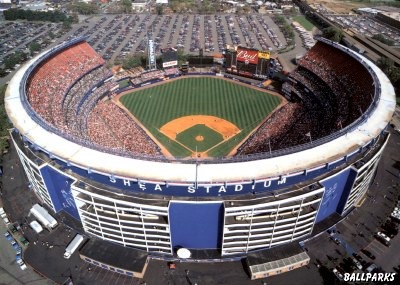Shea Stadium
Flushing, New YorkTenant: New York Mets (NL) Architect: Praeger-Kavanaugh-Waterbury New York Mets tickets:
Location: Center field (E by NE), 126th Street; third base (N by NW), Whitestone Expressway/I-678 and Flushing Bay; home plate (W by SW), Grand Central Parkway; first base (S by SE), Roosevelt Avenue; in Queens, near Flushing Meadow Park, site of the 1939 and 1964 World’s Fairs, just southeast of La Guardia Airport. Dimensions: Foul lines: 330 (marked, l964), 341 (actual, 1964), 341 (1965), 338 (1979); power alleys: 371, 378 (current); center field: 410; backstop: 80; foul territory: very large. Fences: Foul lines: 16.33 (4 wire and railing above 12.33 brick, 1964), 12.33 (brick, 1965), 8 (wood, 1979); power alleys: 8 (wood); center field small section: 8.75 (wood), most 8 (wood). Shea Stadium is named after William Alfred Shea, an attorney who was instrumental in acquiring a new team for New York following the city's abandonment by the Giants and the Dodgers in the 1950s. Appointed chairman of the Baseball Commission by then New York mayor Robert Wagner, Shea first tried to get the Cincinnati Reds, the Pittsburgh Pirates, or the Philadelphia Phillies to move to New York, but had no luck. He then tried to organize a third major league, the Continental League, in 1958, with a franchise for New York, but the league died before a single game was played. In 1960, National League owners decided to expand to 10 teams and awarded franchises to Houston and New York. There were rumors that New York would be rejected unless it guaranteed construction of a new stadium. At Shea’s suggestion, Wagner sent telegrams to each owner with such an assurance, and the Mets started play in 1962.
Originally, the Mets were to play only one season at the Polo Grounds, the former home of the New York Giants. However, construction of the new ballpark fell behind schedule. Shea Stadium cost $28.5 million to build and took 29 months from its groundbreaking on October 28, 1961, to its dedication on April 17, 1964. It was originally to be called Flushing Meadow Park, but a movement was quickly launched to name it in honor of Shea. The stadium contains 24 ramps and 21 escalators. It was also the first stadium capable of being converted from baseball to football and back using two motor-operated stands that moved on underground tracks. Shea Stadium is the noisiest outdoor ballpark in the majors because it is in the flight path of La Guardia Airport. The story goes that when the city scouted out stadium sites in 1962, they went during the winter, when flight paths into La Guardia are different, so they never anticipated the aircraft noise. Plans were drawn up to add 15,000 seats and cover the stadium with a dome. Those plans were scrapped when studies showed the stadium might collapse under the weight of a roof. An article in the February 1, 1996 issue of the New York Times reported that the Mets plan on building a new ballpark in Queens some time in the next ten years. The owner said that he wanted the new park to resemble Ebbets Field with a retractable roof. On Sunday, September 28, 2008, the Mets played their final game at Shea Stadium, a 4-2 loss to the Florida Marlins. In 2009, the team began playing at Citi Field, their new home, built adjacent to Shea Stadium. Shea Stadium Trivia:
More on Shea Stadium: Recommended Reading (bibliography):
New York Mets Help us provide a better web site by completing our feedback form PHOTOGRAPHS: Aerial view of Shea Stadium © 2000 by Mike Smith. Updated September 2008 Tickets to Mets Braves, Mets Yankees, NCAA Basketball Tournament, College Football Bowl, NCAA Football, New York Mets, New York Jets, Paul McCartney and Wicked New York provided by Ticket Triangle. BALLPARKS © 1996-2014 by Munsey & Suppes.
|









